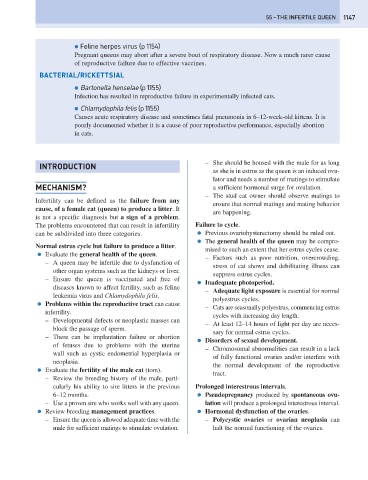Page 1155 - Problem-Based Feline Medicine
P. 1155
55 – THE INFERTILE QUEEN 1147
● Feline herpes virus (p 1154)
Pregnant queens may abort after a severe bout of respiratory disease. Now a much rarer cause
of reproductive failure due to effective vaccines.
BACTERIAL/RICKETTSIAL
● Bartonella henselae (p 1155)
Infection has resulted in reproductive failure in experimentally infected cats.
● Chlamydophila felis (p 1155)
Causes acute respiratory disease and sometimes fatal pneumonia in 6–12-week-old kittens. It is
poorly documented whether it is a cause of poor reproductive performance, especially abortion
in cats.
– She should be housed with the male for as long
INTRODUCTION
as she is in estrus as the queen is an induced ovu-
lator and needs a number of matings to stimulate
MECHANISM? a sufficient hormonal surge for ovulation.
– The stud cat owner should observe matings to
Infertility can be defined as the failure from any
ensure that normal matings and mating behavior
cause, of a female cat (queen) to produce a litter. It
are happening.
is not a specific diagnosis but a sign of a problem.
The problems encountered that can result in infertility Failure to cycle.
can be subdivided into three categories. ● Previous ovariohysterectomy should be ruled out.
● The general health of the queen may be compro-
Normal estrus cycle but failure to produce a litter.
mised to such an extent that her estrus cycles cease.
● Evaluate the general health of the queen.
– Factors such as poor nutrition, overcrowding,
– A queen may be infertile due to dysfunction of
stress of cat shows and debilitating illness can
other organ systems such as the kidneys or liver.
suppress estrus cycles.
– Ensure the queen is vaccinated and free of
● Inadequate photoperiod.
diseases known to affect fertility, such as feline
– Adequate light exposure is essential for normal
leukemia virus and Chlamydophila felis.
polyestrus cycles.
● Problems within the reproductive tract can cause
– Cats are seasonally polyestrus, commencing estrus
infertility.
cycles with increasing day length.
– Developmental defects or neoplastic masses can
– At least 12–14 hours of light per day are neces-
block the passage of sperm.
sary for normal estrus cycles.
– There can be implantation failure or abortion
● Disorders of sexual development.
of fetuses due to problems with the uterine
– Chromosomal abnormalities can result in a lack
wall such as cystic endometrial hyperplasia or
of fully functional ovaries and/or interfere with
neoplasia.
the normal development of the reproductive
● Evaluate the fertility of the male cat (tom).
tract.
– Review the breeding history of the male, parti-
cularly his ability to sire litters in the previous Prolonged interestrous intervals.
6–12 months. ● Pseudopregnancy produced by spontaneous ovu-
– Use a proven sire who works well with any queen. lation will produce a prolonged interestrous interval.
● Review breeding management practices. ● Hormonal dysfunction of the ovaries.
– Ensure the queen is allowed adequate time with the – Polycystic ovaries or ovarian neoplasia can
male for sufficient matings to stimulate ovulation. halt the normal functioning of the ovaries.

